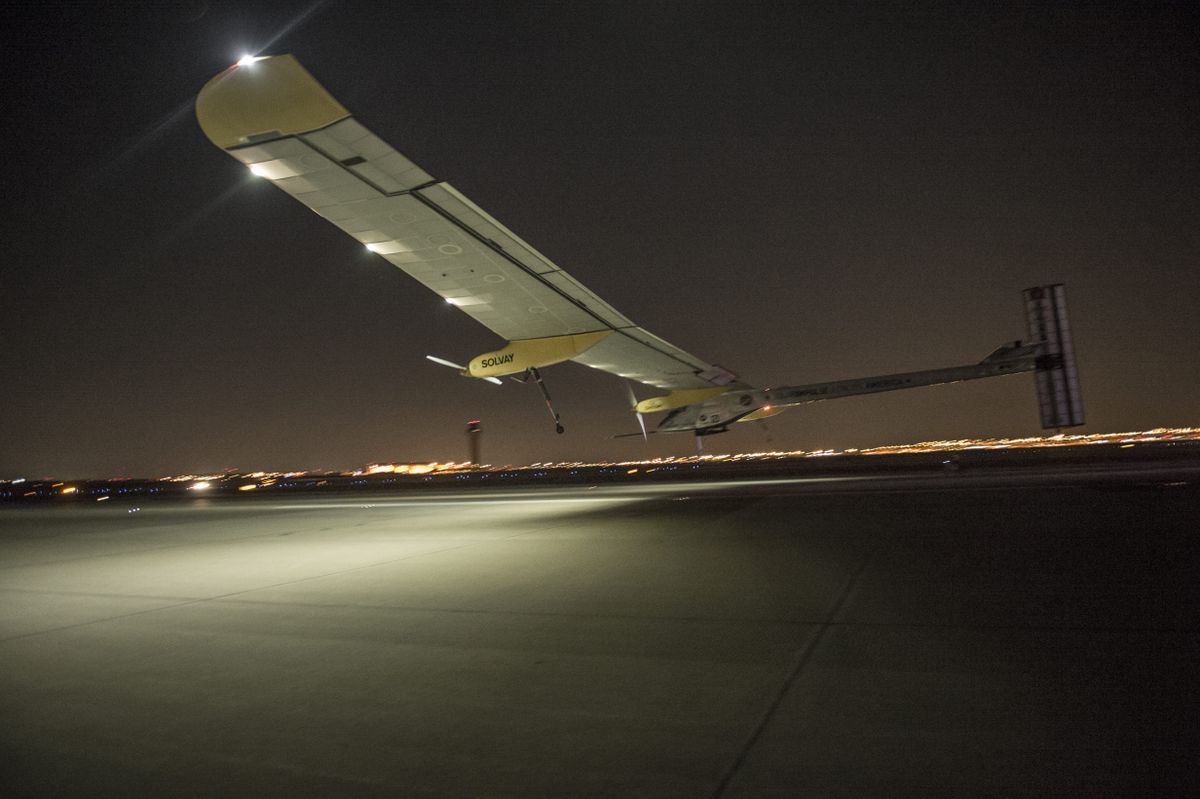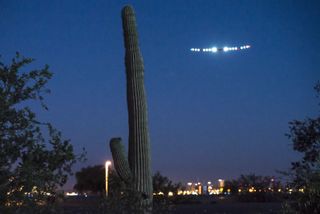Solar Plane Completes Longest Leg of Cross-Country Flight

A solar-powered airplane successfully completed the longest leg of its historic coast-to-coast flight across the United States today (May 23), landing in Dallas after nearly 20 hours in the air.
The aircraft, dubbed Solar Impulse, made the 957-mile (1,541 kilometers) trip from Phoenix to Dallas without using a single drop of fuel. The plane took off from Phoenix's Sky Harbor International Airport Wednesday (May 22) at 7:47 a.m. EDT (4:47 a.m. local time in Arizona), and landed at Dallas-Fort Worth International Airport at 2:08 a.m. EDT (1:08 a.m. local time in Texas) this morning.
"This leg was particularly challenging because of fairly strong winds at the landing," Swiss pilot André Borschberg, co-founder and CEO of Solar Impulse, said in a statement. "It also was the longest flight — in terms of distance — ever flown by a solar airplane. You have to understand that the pilot needs to stay awake for more than 20 hours without any autopilot." [Images: Cross-Country Flight in a Solar-Powered Plane]
The flight, which was the second leg of the plane's cross-country journey, set a new world distance record in solar aviation, according to company officials. The previous distance record was established on a different Solar Impulse flight, when Borschberg piloted the aircraft from Switzerland to Spain in May 2012.

Toward the end of this month, Solar Impulse will depart for St. Louis, Mo., on the third leg of its expedition; the fourth leg will take the plane from St. Louis to Washington, D.C.; and the fifth and last leg will end in New York City in late June or early July, company officials have said.
Each Solar Impulse flight will be streamed live online, featuring commentary and information on the airplane's position, altitude and speed. The live feed will also show camera views inside the cockpit, as well as views from Solar Impulse's mission control center in Switzerland.
Solar Impulse is the first aircraft capable of flying day and night without any fuel. The plane is equipped with solar panels and onboard batteries for power. During today's flight from Phoenix to Dallas, the aircraft reached its highest altitude at 27,000 feet (8,230 meters), and clocked an average ground speed of 52 mph (84 km/h).
Sign up for the Live Science daily newsletter now
Get the world’s most fascinating discoveries delivered straight to your inbox.
The aircraft's solar panel-covered wings span roughly the same length as a 747 jetliner, and can generate the same amount of power as a small scooter, according to company officials.
The historic coast-to-coast flight is designed to demonstrate the vast potential for "clean technologies" and renewable energy. The journey is also launching an initiative called "Clean Generation," which is aimed at promoting the use of clean technologies around the world.
Some of the Clean Generation Initiative's high-profile supporters include former astronaut Buzz Aldrin, Hollywood director James Cameron, environmentalist and former U.S. Vice President Al Gore, and British entrepreneur Richard Branson.
Solar Impulse is organizing a number of public events during its stopover in the Dallas-Fort Worth area, including school visits and open houses.
Borschberg and his Solar Impulse co-founder Bertrand Piccard are alternating flying the single-seater plane over the five legs of the cross-country trip. Piccard will next pilot Solar Impulse to Lambert-St. Louis International Airport, but the departure date for the flight will depend on weather conditions, company officials said.
Follow Denise Chow on Twitter @denisechow. Follow LiveScience @livescience, Facebook & Google+. Original article on LiveScience.com.

Denise Chow was the assistant managing editor at Live Science before moving to NBC News as a science reporter, where she focuses on general science and climate change. Before joining the Live Science team in 2013, she spent two years as a staff writer for Space.com, writing about rocket launches and covering NASA's final three space shuttle missions. A Canadian transplant, Denise has a bachelor's degree from the University of Toronto, and a master's degree in journalism from New York University.










